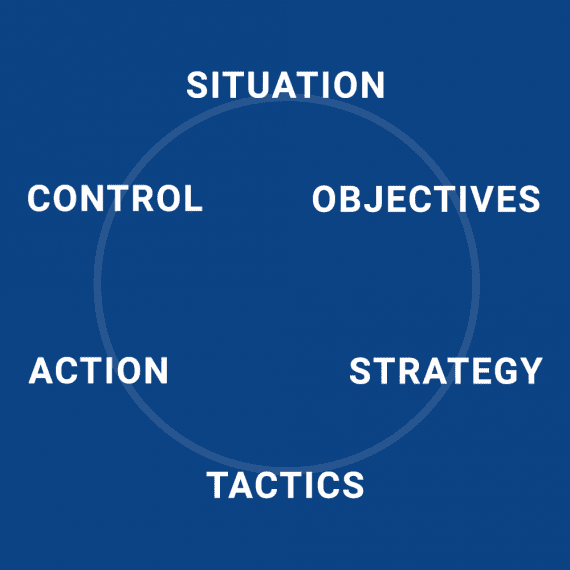There are perhaps three ways to use SOSTAC: as a guide, as a piecemeal resource, or adopted whole.
Guide. A busy commerce company could benefit from pausing to think about marketing as a multi-step process heavy on analysis and strategy. Thus, the framework can serve as a guide to improve incumbent planning procedures.
The planning framework is a six-step cycle. The name of each step forms the acronym SOSTAC, which Smith has registered as a trademark.
For example, during Situational Analysis, a planner might use the 5 C’s – Company, Collaborators, Customers, Competitors, and Context.
A 6-step Process

But a business that grows in complexity and scale often becomes more challenging to market. A founder who intuitively understood the company’s customers and products will need to train its expanding marketing team to carry success forward.
Smith describes SOCTAC in a short video his firm published on YouTube in 2020.
At each step in the SOSTAC process, marketers are encouraged to use one or more additional tools or models.

- Situation Analysis. What is the business’s current situation or state?
- Objectives. What is the business’s desired situation or state?
- Strategy. Broadly, how will the business achieve its objectives?
- Tactics. What will the specific marketing campaigns be?
- Action. How will those tactics be executed?
- Control. How will success be measured?
The context might be described in terms of a PESTEL analysis, wherein the planner thinks about the business in light of Political, Economic, Social, Technological, Environmental, and Legal conditions.
As she identifies the business’s customers — why they buy and how they shop — the planner could segment customer groups and, perhaps, plot them on the Boston Consulting Group’s growth-share matrix or analyze the company’s customer acquisition costs and customer lifetime value ratios.
Throughout the framework, a marketer might integrate ideas from the books “Good to Great” (by Jim Collins), “Blue Ocean Strategy” (W. Chan Kim and Renée Mauborgne), “Jobs to be Done” (Anthony W. Ulwick), or “Traction: Get a Grip on Your Business” (Gino Wickman).
Heavy on Situation, Strategy
[embedded content]
Objectives should be quick, taking up about 5% of the planning process — Situation Analysis makes setting Objectives easy — and developing Tactics might take 30% of planning time.
Some direct-to-consumer brands have almost certainly launched and been successful because the company’s founder was a Facebook ad expert.
Marketing and business consultant Paul R. Smith developed a detailed planning process to help his clients in the 1990s. He later codified that process in a series of books starting with “Marketing Communications: An Integrated Approach” in 1998.
Other Models, Tools
The process is meant to be iterative, wherein the measurements taken and analyzed in the Control step inform the Situation Analysis.
Smart Insights, an educational platform, suggested that while planning marketing, SOSTAC practitioners should spend 20% of their time on Situation Analysis and 45% on Strategy.
SOSTAC describes a planning process for high-performance marketing.
Smith’s framework focuses on situation and strategy. It’s the opposite of quickly launching a Google or Facebook campaign.
Developed more than 25 years ago, the SOSTAC framework can help marketers better understand their business, their customers, and the actions needed to grow sales and profits.
Smith’s first book is a couple of years older than Google Ads (then AdWords), launched in 2000, and some nine years ahead of Facebook Ads in 2007.
The results of the Situational Analysis might be shared in a SWOT grid (Strengths, Weaknesses, Opportunities, Threats) or the TOWS version (Threats, Opportunities, Weaknesses, Strengths) of that grid.
Use parts. Some companies might select pieces of the framework to add to their current process. For example, during the Action step in SOSTAC, marketers are encouraged to create complementary internal communication describing the Strategy, Objectives, and Tactics. This can help with execution and support throughout the business.
Using SOSTAC
Adopt. A business can adopt the entire SOSTAC process. Its thoroughness makes it a good choice for data-driven and outcome-driven companies.
In this way, SOSTAC is adaptable. It allows a planner to work through each step using the tools applicable to the company while exposing areas with insufficient information.
This makes sense since Situational Analysis and Strategy focus on understanding the business, its competition, and its customers. In a sense, it emphasizes the idea that you should know yourself, your market, and your customer.
Digital advertising is seemingly easy. Anyone with a payment card and a few minutes can set up a campaign on Google or Facebook. That campaign may generate sales.

![[VIDEO] The Quick (and Easy) Start to Omnichannel Optimization for Your Business](https://research-institute.org/wp-content/uploads/2021/07/video-the-quick-and-easy-start-to-omnichannel-optimization-for-your-business-768x576.jpg)



